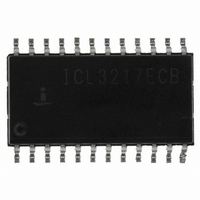ICL3217ECB Intersil, ICL3217ECB Datasheet - Page 9

ICL3217ECB
Manufacturer Part Number
ICL3217ECB
Description
IC TXRX RS-232 3-5.5V ESD 24SOIC
Manufacturer
Intersil
Type
Transceiverr
Datasheet
1.ICL3207ECBZ.pdf
(12 pages)
Specifications of ICL3217ECB
Number Of Drivers/receivers
5/3
Protocol
RS232
Voltage - Supply
3 V ~ 5.5 V
Mounting Type
Surface Mount
Package / Case
24-SOIC (7.5mm Width)
Lead Free Status / RoHS Status
Contains lead / RoHS non-compliant
Available stocks
Company
Part Number
Manufacturer
Quantity
Price
Company:
Part Number:
ICL3217ECB
Manufacturer:
Intersil
Quantity:
150
Part Number:
ICL3217ECB
Manufacturer:
INTERSIL
Quantity:
20 000
Company:
Part Number:
ICL3217ECBZ-T
Manufacturer:
TOSHIBA
Quantity:
2 140
Human Body Model (HBM) Testing
As the name implies, this test method emulates the ESD
event delivered to an IC during human handling. The tester
delivers the charge through a 1.5kΩ current limiting resistor,
making the test less severe than the IEC61000 test which
utilizes a 330Ω limiting resistor. The HBM method
determines an ICs ability to withstand the ESD transients
typically present during handling and manufacturing. Due to
the random nature of these events, each pin is tested with
respect to all other pins. The RS-232 pins on “E” family
devices can withstand HBM ESD events to ±15kV.
IEC61000-4-2 Testing
The IEC61000 test method applies to finished equipment,
rather than to an individual IC. Therefore, the pins most likely
to suffer an ESD event are those that are exposed to the
outside world (the RS-232 pins in this case), and the IC is
tested in its typical application configuration (power applied)
rather than testing each pin-to-pin combination. The lower
current limiting resistor coupled with the larger charge
storage capacitor yields a test that is much more severe than
Typical Performance Curves
FIGURE 10. TRANSMITTER OUTPUT VOLTAGE vs LOAD
-2.0
-4.0
-6.0
6.0
4.0
2.0
0
0
1 TRANSMITTER AT 250kbps
OTHER TRANSMITTERS AT 30kbps
CAPACITANCE
1000
LOAD CAPACITANCE (pF)
2000
9
3000
V
CC
V
V
4000
OUT
OUT
= 3.3V, T
+
-
ICL3207E, ICL3217E
5000
A
= 25°C
the HBM test. The extra ESD protection built into this
device’s RS-232 pins allows the design of equipment
meeting level 4 criteria without the need for additional board
level protection on the RS-232 port.
AIR-GAP DISCHARGE TEST METHOD
For this test method, a charged probe tip moves toward the
IC pin until the voltage arcs to it. The current waveform
delivered to the IC pin depends on approach speed,
humidity, temperature, etc., so it is difficult to obtain
repeatable results. The “E” device RS-232 pins withstand
±15kV air-gap discharges.
CONTACT DISCHARGE TEST METHOD
During the contact discharge test, the probe contacts the
tested pin before the probe tip is energized, thereby
eliminating the variables associated with the air-gap
discharge. The result is a more repeatable and predictable
test, but equipment limits prevent testing devices at voltages
higher than ±8kV. All “E” family devices survive ±8kV contact
discharges on the RS-232 pins.
25
20
15
10
5
FIGURE 11. SLEW RATE vs LOAD CAPACITANCE
0
+SLEW
-SLEW
1000
LOAD CAPACITANCE (pF)
2000
3000
-SLEW
4000
5000












